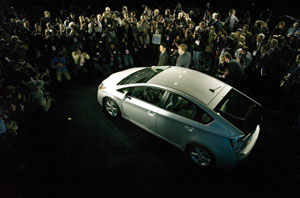Electric propulsion provides some excitement amid the gloom
THE sombre mood at this year’s Detroit motor show manifested itself most visibly in the austerity of the exhibitors’ displays, and Chrysler’s in particular. Over the years the smallest of America’s Big Three manufacturers has introduced new models by driving a sport-utility vehicle through the plate-glass windows of the Cobo Hall, dropping a pickup from the roof and firing a minivan through the air. But having just received a life-saving government bail-out, Chrysler did not want to appear extravagant. Gone were the over-the-top stunts and computer-controlled fountains. Instead it opted for a simple exhibit that resembled a giant showroom.

A beacon in the darkness
General Motors (GM), the recipient of its own bail-out, also opted for the corporate hair shirt. Ford, the strongest of the Big Three, was careful not to appear too flashy. And even the Japanese carmakers, wary of reviving protectionist sentiments, took a low-key approach. Only the Germans were in a party mood. Some carmakers, including Nissan, Land Rover and Porsche, did not attend the show at all—understandably, given the collapse of America’s car market during 2008.
One of the few bright spots amid the gloom was the nearly universal enthusiasm for hybrid and electric vehicles. Almost every maker had a hybrid or all-electric car on display, and the word “electrification” was on everyone’s lips. A disproportionate number of the new vehicles unveiled at the show relied on some form of electric propulsion, with carmakers as diverse as GM, Mercedes-Benz, Toyota and China’s BYD pulling the wraps off an assortment of hybrids, plug-ins and all-electric vehicles.
Most anticipated was the introduction of the newest version of Toyota’s Prius (pictured), the world’s bestselling hybrid car. It is slightly more aerodynamic than its predecessor and has several nifty new options, including a ventilation system powered by solar panels on the roof. But one feature it still lacks is a plug for recharging: Toyota says battery technology must improve further before it launches a “plug-in” Prius, capable of making local trips on battery-power alone and recharging from the mains. For its part, GM showed the “production ready” version of the Chevrolet Volt, its plug-in hybrid, due in 2010.
A 50% fall in American sales of hybrid cars in the final months of 2008, as the price of petrol fell along with the oil price, took some of the shine off the new Prius. Cars for which there were waiting lists only a year ago are being offered at a discount, and Toyota has delayed the opening of a new Prius factory in America. But many in the industry think it is only a matter of time before petrol prices rise again, and that electric propulsion is the future.
Beyond hybrids, several all-electric vehicles were on display in Detroit, both from well known makers such as Mercedes-Benz, with its Blue Zero E-Cell concept car, and also from ambitious newcomers such as Tesla Motors, based in Silicon Valley, and BYD, a Chinese battery-maker that has branched out into electric cars in recent years. Most makers talk of battery packs that take up to eight hours to charge and provide a range of around 100 miles, but BYD claims its “lithium ferrous phosphate” battery technology can provide a range of 250 miles with as little as three hours of charging.
Furthermore, BYD says its batteries cost roughly half as much as rival lithium-based designs. Elon Musk, the founder of Tesla, is sceptical: “No bloody way,” he says. But BYD is enticing enough for Warren Buffett to have invested $230m for a 10% stake in the Chinese firm. The legendary investor, at least, is convinced.
Source: The Economist
Short link: http://whatel.se/~A6Y1$2C

Recent Comments